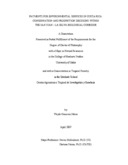| dc.contributor.advisor | Hollenhorst, Steven | es_Es |
| dc.contributor.author | Morse, Wayde C. | |
| dc.date.accessioned | 2014-10-20T05:25:50Z | |
| dc.date.available | 2014-10-20T05:25:50Z | |
| dc.date.issued | 2007 | es_ES |
| dc.identifier.uri | https://repositorio.catie.ac.cr/handle/11554/5397 | |
| dc.description | Tesis (Doctorado) -- CATIE. Escuela de Posgrado, Turrialba (Costa Rica), University of Idaho, 2014 | es_ES |
| dc.description.abstract | This dissertation develops a model linking social and ecological theories to explain this interaction. This model is applied to Costa Rica’s program of payments for environmental service (PES) as a case example. The model has potential for application to land use change studies in general and evaluation of PES prograMON specifically.Forest change observations were explained by landowner survey data, indicating that PES positively influenced forest retention and recruitment. Secondary forest carbon storage approached values found in primary forest after 25-30 years of succession, though few landowners retained natural forest regeneration. The Costa Rican experience provides evidence that PES have been effective at providing environmental services within this particular socioeconomic context. | es_ES |
| dc.language.iso | en | es_ES |
| dc.publisher | Centro Agronómico Tropical de Investigación y Enseñanza (CATIE), Turrialba (Costa Rica) University of Idaho, Moscow, ID (EUA) | es_ES |
| dc.rights | info:eu-repo/semantics/openAccess | |
| dc.subject | BOSQUES | |
| dc.subject | BOSQUE SECUNDARIO | |
| dc.subject | ECOSISTEMA | |
| dc.subject | MEDIO AMBIENTE | |
| dc.subject | CONSERVACION DE LA NATURALEZA | |
| dc.subject | UTILIZACION DE LA TIERRA | |
| dc.subject | COSTA RICA | |
| dc.title | Payments for environmental services in Costa Rica: conservation and production decisions within the San Juan - La Selva Biological Corridor | es_ES |
| dc.type | Tesis de doctorado | es_ES |
| dc.identifier.publication | Turrialba (Costa Rica) | es_ES |


